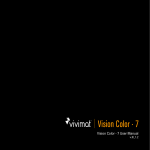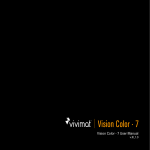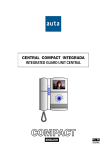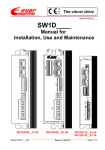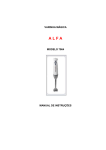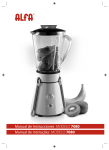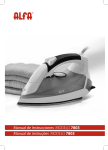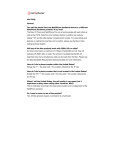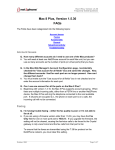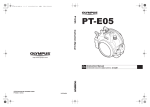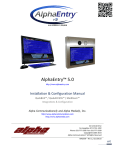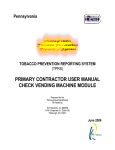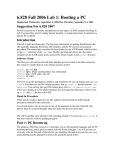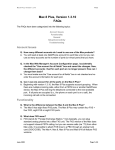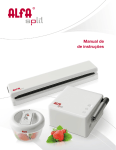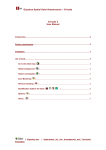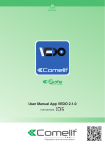Download NOTA-14.1_Control climático con vivimatIII_corregido
Transcript
Video doorphone integration with vivimat ® III Ref: NA-17_v.III Implicated elements In the following application note the following elements are discussed: Ref. vivimat® 3.0 - vivimat® 3.0 controller board and power supply Ref. vivimat® project - Software to configure vivimat® III systems Ref. P-VISION-C7(X) - 7” Color screen Ref. MOD-0200 - Video doorphone connection module Ref. MOD-0350 - GSM module Ref. MOD-0800 - Audio expansion module. If you need more specific information on the characteristics of any of them, please refer to the technical data sheets. Functionality The vivimat® III systems can provide video doorphone services adding the video doorphone management specific module, Ref. MOD-0200. This module is connected to the central unit. The vivimat® III systems are compatible with the AUTA COMUNICACIONES S.L. video doorphone systems. From now on, Auta. If you want detailed information about the Auta video doorphone systems, consult the technical catalogues. The vivimat® III systems are compatible with the following Auta systems: Product range Compact Digital Dom (Special version for vivimat systems) Series Models S1, S2, S3, S4 and S5 T, TT and P Decor Digital S1, S2, S3, S4 and S5F y FV (F: talking, FV: talking/video) Both product ranges have models with a keyboard or buttons. A vivimat® III system with video doorphone function is composed of the following elements: Component vivimat® central unit Screen Door Digital Compact Digital Dom Description vivimat® III central unit with MOD-0001 & MOD-0200 P-VISION-C7(X) Door Station Door Station Reference vivimat® 3.0 P-VISION-C7(X) (various models) (various models) AUTA Video doorphone integration with vivimat ® III Embedded box Video door pone power supply Boxes to embed the different door stations (X=1 series 1, ....X=5 series 5) 50902X Up to 10 housings: Power supply ATF-98 Up to 40 housings: Power supply ALV-3.5A + Auxiliary power supply ATF-12 715403 715203 Required when using audio modules 600005 Control module with keypad for door stations 600006 Required to unite 2 or 3 button-door stations 600002 The SDL allows to communicate from various common external accesses with one of the interior buildings. 730137 Door opener. Door opener MOD. A 720001 Video distributor Coaxial video distributor system DVC-4S (for every 4 housings a distributor is required) 750498 Digital control module Keyboard control module Connection module rows/columns SDL-line digital selector 715103 The door stations can be with a keyboard or buttons. Door stations with buttons: Are the most popular option. Their main advantage is its ease of use by having a call button for each housing. The main disadvantage of such door stations is that if the number of houses connected is high (over 20), you may require using multiple door stations connected together, and thereby increasing the cost and complexity. Door stations with keyboard: Its main advantage is that you can call a large number of homes with just one door station. Its disadvantage is that the handling is not as intuitive as the button door stations. Another advantage of these door stations is that they allow the opening of the door by entering a secret PIN. Video doorphone integration with vivimat ® III Encoding of the digital system with door station with buttons Step 1. How does the digital system work: Each button of the door station has a different call code assigned. When you press the call button, the door station sends that code to all the vivimat® central units. The central unit that has this code assigned will answer. The code assignment for each vivimat® central unit is carried out via an 8 position selector located in the MOD-0200 of the central unit. The central unit is only activated when the MOD-0200 module is encoded and receives its call code from the door station. Step 2. How to assign call codes: Locate yourself with the code template next to the door station. Type in the door station, starting with the button marked with a star, the number of each housing as indicated in the drawing. Diagram of AUTA. For more information of the diagram, see the specific manual of AUTA Step 3. Encoding in the vivimat central unit: Go back into the housing with the code template and encode the central unit accordingly to the button that calls this housing. Video doorphone integration with vivimat ® III Diagram of AUTA. For more information of the diagram, see the specific manual of AUTA Codes template Diagram of AUTA. For more information of the diagram, see the specific manual of AUTA Video doorphone integration with vivimat ® III Configuring the switches of the central units Diagram of AUTA. For more information of the diagram, see the specific manual of AUTA Video doorphone integration with vivimat ® III Installation Connection between the vivimat® III central unit, terminals and AUTA control module: AUTA CONTROL MODULE - Voa AUTA 24V 07 IN5 IN6 GND IN7 IN8 GND AIN FIN 06 PHONE _ LINE Vo Vo VI3 VI2 _ VI1 05 VI1 COAXIAL 02 04 IN1 IN2 GND IN3 IN4 03 MEMORY CARD MAIN BOARD OF VIVIMAT 3.0 TP19 GND CN10 A2 +V2 GND B1 +V1 +V1 +V1 GND +VA GND +VB A1 +V2 +V4 +V1 GND B2 GND TT CN5A CN5B EXPANSION BUS TAMPER GND SIN SOUT GND SIN SOUT GND +V A B GND IN +V3 01 CN26 GND SIN OUT 08 + _ CN27B B1 GND +V2 A1 Video doorphone integration with vivimat ® III Connection of the digital door station with buttons with a control module. Diagram of AUTA. For more information of the diagram, see the specific manual of AUTA Video doorphone integration with vivimat ® III Connecting the door stations with the power supply. The door opener and the drip moulding of the building (1 street panel): Diagram of AUTA. For more information of the diagram, see the specific manual of AUTA MOD-0200 4 WIRES+COAXIAL Video doorphone integration with vivimat ® III Connecting the door stations with the power supply. The door opener and the drip moulding of the building (2 street panels): Diagram of AUTA. For more information of the diagram, see the specific manual of AUTA Go to page 11 of the Application Note Video doorphone integration with vivimat ® III Go to page 11 of the Application Note Go to page 11 of the Application Note Diagram of AUTA. For more information of the diagram, see the specific manual of AUTA Video doorphone integration with vivimat ® III Video distribution for screen Connection of the monitors and vivimat® III central unit of the housing: MOD -0200 MOD -0200 MOD -0200 MOD -0200 MOD -0200 MOD -0200 MOD -0200 MOD -0200 Diagram of AUTA. For more information of the diagram, see the specific manual of AUTA Video doorphone integration with vivimat ® III Configuration of Decor Plus digital pannel Information of AUTA. For more information of the diagram, see the specific manual of AUTA Configuration Menu (C + Bell + Config. Menu Code (‘1’) + Bell) - This menu has been created to set the following 7 Panel Parameters: - OPEN CODE. 4 different common “Open Codes” up to 6 digits, to be assigned to the postman or to the doorman, but not usually to the neighbours of the building. By default these codes are 101010, 202020, 303030, and 404040. Set any open code to the value 0 implies to disable it. - OPEN TIME. 2 different configurable “Open Times”. The first one will be used when the user is outside the building3 and the second one if the user is inside the building (pressing the hall-button inside the building. This open time is usually longer). By default the Time1=5 seconds and the Time2 = 8 s. (Max Time for both = 9 seconds). - PANEL NUMBER. There are not dip-switches any more to set the panel number. Now it is configured with the keyboard. By default it will be set to 1. Up to 15 panels could be configured. - PANEL internal / external. The Panel should be configured as ‘external’ if it performs the call through an SDL (connected to the X (external) line of the SDL) otherwise the Panel will be configu red as ‘internal’. From the v2.0, the screen will also show the software version and an internal identification code. - SELF STARTING. The self-starting can be enabled or disabled in this menu. - SWITCHBOARD. This option should be enabled if the installation has a switchboard linked to the DecorPlus panel. This means that any call code (even a non existing one) will make a call to the switchboard. If this option is configured as ‘SWITCHBOARD: no’ there it is still the possibility to assign the call code ‘0’ to a telephone / monitor that will work as if it was a switchboard. The non existing codes introduced in the panel, will also be redirected to this telephone / monitor. If the installation needn’t switchboard functions, it is recommended to set ‘SWITCHBOARD: no’ and be sure not having any call code ‘0’ in the data base.4 - NEW ACCESS CODE. It is strongly recommended to change the codes of the Configuration & Directory menus. Keep in mind that these codes were, by default, ‘1’ and ‘9’ respectively. • To navigate through the different parameters, we must press the C key, and to change&confirm between the different options of the same parameter, the Bell key should be pressed. Any numerical parameter can be changed directly with the numeric keyboard, and if we want to exit this menu, the Bell key must be pressed when the ‘Exit?’ screen is reached. NOTES: 3 That is when we call to a flat and someone opens the door, also when we introduce our personal Open Code or a general Open Code. 4 If there is a guard porter button in the installation and it is pressed: If ‘SWITCHBOARD: yes’ it will make a call to the guard porter, if ‘SWITCHBOARD: no’ it will call to the telephone / monitor with the call code 0 only if it exists in the data base. GENERAL COMMON DOWN-HOLE 4 wires + coaxial Main monitor J2 position 1-2 secondary monitor VIVIMAT VIDEO CENTRAL UNIT VIVIMAT VIDEO CENTRAL UNIT Configure both equpments with the same call code COMPACT DIGITAL MONITOR Video doorphone integration with vivimat ® III Diagram of AUTA. For more information of the diagram, see the specific manual of AUTA Video doorphone integration with vivimat ® III Connection between vivimat ® III central unit and the terminals Connecting various P-VISION-C7(X) screens to the central unit: SCREEN 1 vivimat® 3.0 CONTROLLER BOARD 2 INTERFACE BUS 4 3 AUDIO BUS 1 MOD-0200 SCREEN 2 DVC-45 2 2 4 COAXIAL 3 SCREEN 3 AUDIO BUS 2 2 MOD-0800 4 3 AUDIO BUS 3 Configuration To configure the video door phone system in the housing with vivimat® Project, please refer to the vivimat® Project user manual, section 5.7.9.3.2 Video Door Phone. Using the video doorphone system The use of the video doorphone through vivimat® III avoids the use of the video doorphone screen, because all the control is carried out by the P-VISION-C7(X) screen. Besides the normal use of the video doorphone, open the door, answer a call, turn up/down the volume, etc. it allows: - Control of the doorphone from the internal telephones of the housing: talk/listen and open the door. - Call diversion from the video doorphone to the telephone. - Voice mail of the video doorphone. Consult the user’s manual of the P-VISION-C7(X) to obtain more information NA-17_28/10/11-ENG Product manufactured by: Dinitel 2000 S.A. - Avda. Otaola 20 20600 Eibar ( Guipúzcoa ) Spain T. +34 902 111 220 / +34 943 820 458 F. +34 902 124 779 www.domotica-vivimat.com [email protected]














